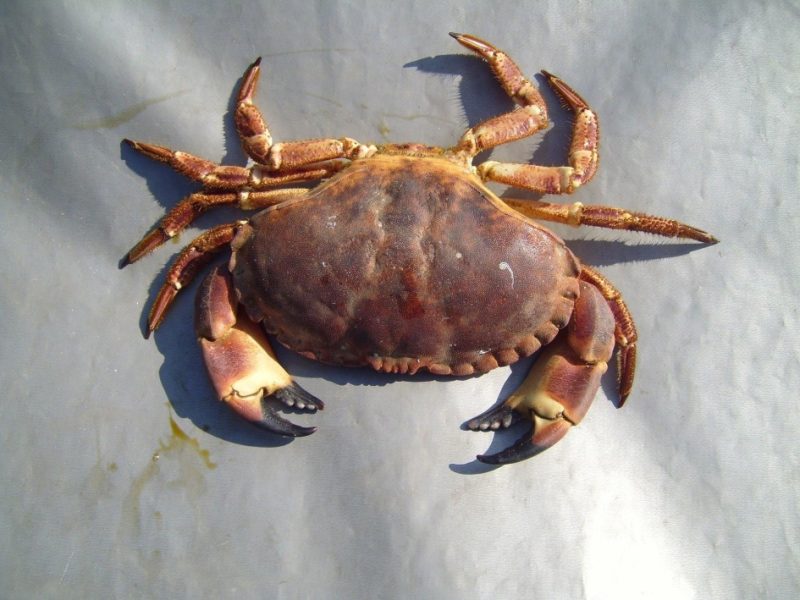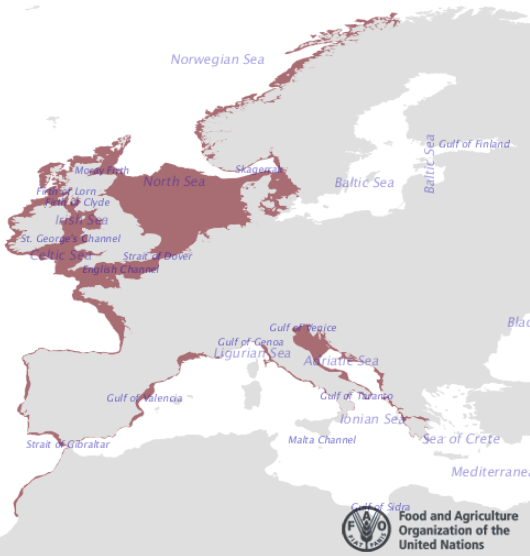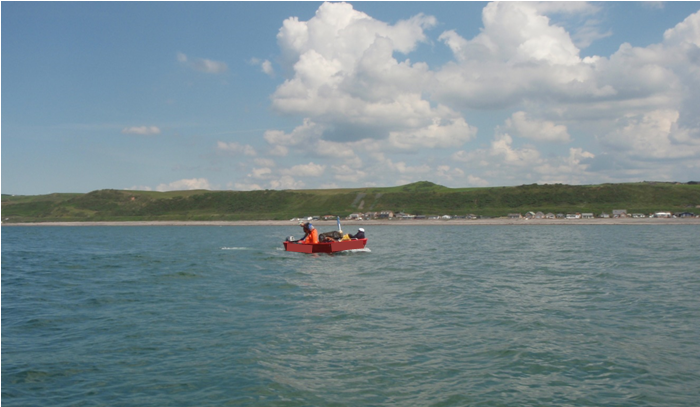Brown / Edible Crab

Scientific name: Cancer pagurus
Also known as: Brown Crab, Edible crab
MCRS: 130mm (carapace width)
Description
This common species is easily identified by its characteristic ‘pie crust’ edge around the carapace and black tipped pincers. They have an oval shaped body and are a reddish brown colour with a carapace width which can grow up to 25 cm in length but usually up to 15 cm.
Habitat and Distribution

Brown crab are distributed throughout the North Sea, Irish Sea, English Channel and down the coast of Portugal. The species is found on all coasts around the UK from the intertidal zone down to 100m. They inhabit rocky ground, particularly under boulders, mixed coarse ground and muddy sand offshore. They hide in cracks and under rocks and buried in soft sediment and emerge to forage for food.
Life Cycle, Reproduction and Feeding
Browns crabs are active predators feeding on a variety of crustacea (including smaller members of their own species), molluscs and echinoderms smaller than themselves. They can be voracious predators of mussels. They are also scavengers of carrion on the sea bed.
Brown crabs growth rates appear to vary depending on a range of variables including food availability, water depth and temperature. They reach sexual maturity at around 11cm. They mate through copulation in spring and summer. Mating occurs shortly after a female has moulted. Females carry eggs under the abdomen and are known as ‘berried’ for this time. Fecundity is between 0.25 and 3 million eggs per female depending on size. They do not feed and remain sheltered under rocks or in pits dug in the sediment to avoid predation, and are unlikely to be caught in baited pot. As a result, fishing pressure does not affect larval supply. Larvae are released in late spring/early summer and exist in the plankton. Survival rates of the pelagic larval stages are low due to high predation while they are in this vulnerable life stage. The individuals go through a process of metamorphosis, and juvenile crabs settle in the intertidal zone in late summer where they remain until they reach a carapace width of 6-7cm, taking around 3 years. They then move to subtidal areas. Adult males usually remain in the intertidal and inshore areas, whereas adult females migrate inshore to mate, offshore to release larvae and then inshore again to feed. They are thought to undertake substantial migrations and inhabit depths up to 100m. Lifespan is thought to be 30-40 years, or even substantially longer.
Moult
Brown crabs are not able to grow linearly like most animals as they have a hard outer shell (exoskeleton) which does not grow with them. They must shed this hard exoskeleton and grow a new one, so they grow in increments. To shed an exoskeleton the crab will absorb seawater and swell up; this expands the old shell causing it to separate. As they lose their exoskeleton they become ‘soft-shelled’, at this point they are very vulnerable to predation and it can take several weeks for a new outer shell to grow and harden. Brown crabs are very difficult to age individually as they lose any age determining structures with every moult.
Additional Information
Brown crabs are mainly nocturnal but remain sheltered when not feeding to avoid predation.
In the NWIFCA District
Brown crab are fished commercially and recreationally within the District. They are mainly fished off the Cumbrian coast and around Walney Island, where the majority of their preferred rocky, coarse habitat is found. The increase in construction of windfarms and associated use of rock armouring for scour protection and cable burial has changed some coastal and offshore habitat from sand or mud to rock, thus increasing available niche habitat for this species.
Brown crab are fished using crab and lobster pots. Pots are set in fleets or strings which consist of a number of pots tied together which sit on the sea floor in a line. Weights are attached to either end of this string/fleet with marker buoys or flags at either end. Pots are baited to attract both crab and lobster, and then left for a period of time known as the ‘soak time’ which can be from 24 hours to 5 days. The longer pots are left the more chance of the bait running out and the increase in risk of fighting and predation between animals trapped within the pot.

Fisheries Management
To fish commercially within the District you must hold a National Shellfish Licence, which restricts the entry of new vessels into the fishery and requires catch and effort information to be returned.
Within the District there are byelaws pertaining to fishing for brown crab. These include permits for recreational fishers, escape gap measures for conservation and requirements for marking gear. These byelaws vary in different parts of the District, and are being consolidated under the Byelaw Review. Find out more here: http://www.nw-ifca.gov.uk/byelaws/
Where commercial potting occurs in Marine Protected Areas it undergoes an assessment to ensure the activity does not cause risk to conservation features. HRAs carried out for potting in the District’s European Marine Sites can be found here.